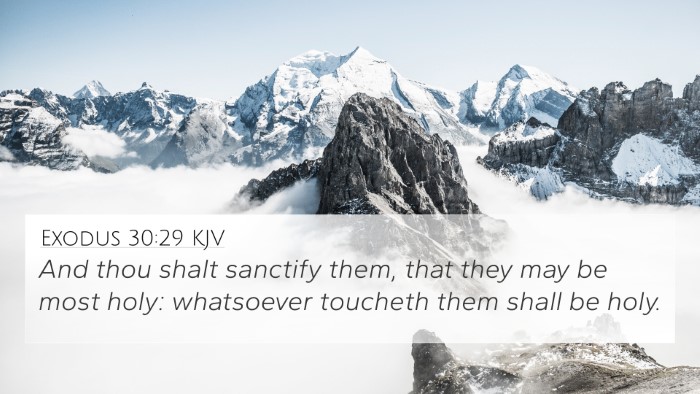Understanding Leviticus 8:11
Leviticus 8:11 states: "And he sprinkled of the anointing oil upon the altar seven times, and anointed the altar and all his vessels, both the laver and his foot, to sanctify them." This verse describes a significant ritual performed by Moses during the consecration of Aaron and his sons as priests, exemplifying the importance of anointing and sanctification in the Hebrew religious tradition.
Significance of Leviticus 8:11
This act not only signifies the setting apart of the altar and its instruments for God’s service but also reflects the deeper theological themes found throughout the Bible regarding holiness and the need for consecration in approaching God.
Meaning and Interpretation
- Priestly Anointing: According to Matthew Henry, the anointing oil represents the presence of the Holy Spirit, signifying that those who serve in sacred roles must be set apart and empowered by divine grace.
- The Role of Symbolism: Adam Clarke points out that the "seven times" signifies completeness and perfection, as it is a number frequently associated with God’s covenant practices.
- Sanctification Process: Albert Barnes notes that the act of anointing serves as a public declaration that these objects are now fit for divine use, demonstrating God's requirement for purity in worship settings.
Cross-References and Connections
Leviticus 8:11 is rich in intertextual connections throughout Scripture. Some relevant cross-references include:
- Exodus 30:26-30: Details on the anointing oil’s ingredients and uses.
- 1 Samuel 10:1: The anointing of Saul as king illustrates the same principle of being set apart for a divine purpose.
- Hebrews 9:21: References the sprinkling of blood in sanctification, paralleling the need for purification in worship.
- 1 Peter 2:9: The concept of believers being a chosen generation relates closely to the priestly anointing seen in Leviticus.
- Isaiah 61:1: The anointing of the Messiah reflects the fulfillment of these priestly themes.
- Matthew 3:16-17: Jesus’ baptism, where He was anointed at the start of His ministry, relates to the sanctification rites of Leviticus.
- Hebrews 10:19-22: Encourages believers to approach God with confidence, alluding to the sacrificial system established in Leviticus.
Thematic Connections
The themes present in Leviticus 8:11 call for a deeper examination of how God commands rituals that reflect His holiness. This reliance on ritual sanctification showcases God’s demand for purity and dedication among His people.
Holiness and Worship
The repeated theme of holiness in worship is prevalent across the Bible. The act of anointing, both ritualistic and symbolic, underlines the essential nature of reverence in action before God, emphasizing the need for preparatory cleansing before worship.
Spiritual Implications
The anointing mentioned in Leviticus 8:11 serves as a profound reminder of Christians’ call to holiness and dedication in their lives. As believers, they are invited not merely to observe rituals but to embody the principles of sanctification and consecration in daily life.
Conclusion
Through a careful examination of Leviticus 8:11, considering its implications both contextually and thematically, one can grasp its enduring significance in biblical narrative and personal faith. This verse, along with its cross-references, highlights the importance of being set apart for God’s service, the necessity for holiness, and how these principles continue to resonate within the framework of Christian theology.
Further Study Recommendations
For those interested in a more in-depth exploration of Leviticus 8:11 and its connections within Scripture, utilizing tools such as a Bible concordance or a Bible cross-reference guide can enhance understanding.
- How to use Bible cross-references: Learning to identify and navigate cross-references can amplify insights gained from reading specific verses.
- Bible cross-reference system: Familiarizing oneself with systems like the Thompson Chain-Reference can aid in quickly finding related scriptures.
- Cross-referencing Bible study methods: Engaging in comparative studies aligns themes with selected texts facilitating richer understanding.










